|
Agriculture in focus but professionals missing
Although agriculture's contribution to the national economy
has fallen from 53 per cent at the time of Independence to 24
per cent now, it still provides employment to 44 per cent of
the labour force.
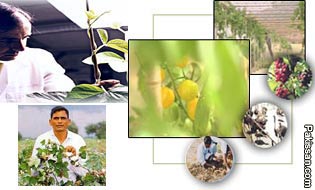 However
its share in the federal budget expenditure of 2003-04 was
1.12 per cent. As a result of this inadequate allocation and
mismanagement of agricultural sector last year a disappointing
growth rate of 2.4 per cent could be achieved as against the
target of 4.2 per cent. However
its share in the federal budget expenditure of 2003-04 was
1.12 per cent. As a result of this inadequate allocation and
mismanagement of agricultural sector last year a disappointing
growth rate of 2.4 per cent could be achieved as against the
target of 4.2 per cent.
Weather has been blamed as the cause of this low production
instead of admitting the inefficiency and mismanagement of the
agriculture managers. Again, agriculture has been treated as
an orphan in the budget of the year 2004-05 .Of the total
budget of Rs903 billion, the share of agriculture is around
Rs11 billion as compared to Rs9.17 billion of the last year.
It amounts to nearly 1.22 per cent of the total budget, in
spite of the reduced share of 23.3 per cent of the GDP due to
negligence of the agriculture sector. This increase of nearly
Rs2 billion this year is nullified by the reduction of
non-development allocation from Rs7.67 billion to Rs3.95
billion.
This year the allocation for public sector development plan
for agriculture in the budget is Rs7.29 billion which comes to
0.8 per cent of the budget . Again ,although the share of
agriculture to national GDP was 23.3 per cent, the funding for
agricultural research ,education and extension was around
0.3-0.4 per cent of the GDP.
As a result 80-90 per cent of the funds are spent on salaries
and maintenance of research and education institutes and
hardly 10-20 per cent is left , which is not adequate for any
meaningful institutional, faculty and post graduate research.
In view of the importance of agriculture, the National
Commission on Agriculture in 1988 recommended the government
that the share of agriculture in the national budget should
not be less than 1.5 per cent and agriculture must be given a
central role in the country,s development strategy.
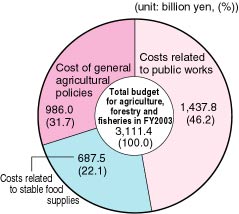 But
even after the lapse of 16 years this recommendation was not
implemented by the successive governments. As a result the
share of agriculture of 26 per cent to GDP in 1988 has come
down to 23.3 per cent in 2003-04. But
even after the lapse of 16 years this recommendation was not
implemented by the successive governments. As a result the
share of agriculture of 26 per cent to GDP in 1988 has come
down to 23.3 per cent in 2003-04.
Due to highly increased cost of inputs, pesticides,
electricity, diesel, farm machinery etc since then, the share
of agriculture in the budget should not be less than 2.5 per
cent in the beginning. Later on it should be adjusted
according to the changes in the share of agriculture to GDP in
the national economy.
Out of the total budget of Rs.903 billion about Rs .600
billion will be met from local resources, while over Rs. 300
billion will be taken as loan from foreign funding agencies in
spite of tall claims of our finance minister of achieving
overall growth rate of 6.4 per cent, increase in foreign
exchange reserves, paying back significant amount of foreign
loans which is still around $35 billion.
Thus on the one hand we are under debt of huge of foreign
loans on the other hand we are begging for more foreign loans
.As a result the foreign donor agencies dictate us policy
decisions and the common man is the ultimate sufferer.
Similar situation prevails in the provincial budgets in spite
of significant contribution of agriculture to the Provincial
Domestic Products (PDP). For instance, in Balochistan
agriculture contributes over 50 per cent to PDP, but its share
in the provincial budget is negligible.
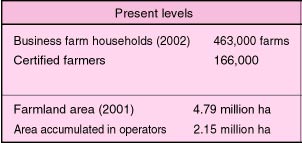 Similarly,
the share of agriculture in the provincial budget of NWFP is
0.8per cent of the total budget, of Sindh it is 1.1 per cent
and in Punjab it is 1.5 per cent of the total budget. Similarly,
the share of agriculture in the provincial budget of NWFP is
0.8per cent of the total budget, of Sindh it is 1.1 per cent
and in Punjab it is 1.5 per cent of the total budget.
Thus agriculture sector has again been treated as an orphan in
the Federal and provincial budgets. General Pervez Musharraf
unfolded a package of incentives for the farmers by bringing
Zarai Taraqiati Bank (ZTB) interest rate on agricultural loans
from 14 to 9 per cent.
It is a good incentive, but it is still higher than 4-6 per
cent interest charged by the commercial banks from the
industrial units. He also announced that agricultural loans
will be raised to Rs80 billion and in addition to ZTB the
commercial banks will also be encouraged to give agricultural
loans, but they should not charge more than 4-6 per cent
interest on agricultural loans to the farmers as charged by
them from industrial units. Agriculture should be treated at
par with industry as it supports directly and indirectly to
the major industries.
The agricultural credit given by the Agricultural Bank of
Pakistan (ADP) and commercial banks increased from Rs12930
million to Rs51704 million during the decade ending in
2002-03.
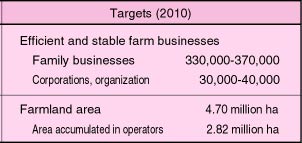 Out
of this actual production loan on seed, fertilizer,
pesticides. tube-wells, drought cattle, tractors and farm
machinery etc ranged from Rs11360 million to Rs43476 million.
The rest was spent on livestock, poultry, fisheries ect. Out
of this actual production loan on seed, fertilizer,
pesticides. tube-wells, drought cattle, tractors and farm
machinery etc ranged from Rs11360 million to Rs43476 million.
The rest was spent on livestock, poultry, fisheries ect.
Hence the loan per cropped hectare ranged from Rs519 in
1993-94 to Rs1985 in 2002-03 or increased from Rs310 per acre
in 1993-94 to Rs804 per acre in2002-03. This was not
sufficient to meet the per cropped acre cost due to
increasingly high cost of quality seed, fertilizer,
pesticides, electricity and diesel for tube wells and high
cost of farm machinery and taxes on agriculture.
Thus, this increase of agricultural loan from Rs57 billion in
2002-03 to Rs80 billion in 2004-05 will provide only nominal
relief to the farming community, especially the small,
subsistent and below subsistent level farmers having 63 per
cent of the total farm land in the country.
Therefore, the government must ensure that nearly 60 per cent
of the agricultural loan is given to the aforementioned
categories of small farmers and the rest to the medium and
large farmers who own 39 per cent of the total farms.
Again, the influential politicians and feudal lords take major
part of the loans against the names of their tenants showing
them as small farmers thus most of actual credit does not go
to many genuine small farmers and landless tenants. The
tragedy is that most of these politically influentials also
get their loans finally written off.
In view of these harsh realities the government should ensure
that nearly 60 per cent of their announced agricultural loan
goes to the small farm categories, besides facilitating the
procedural requirements for taking these loans by the common
farmers.
The other part of the package was reduction of price of DAP
fertilizer by Rs100 per bag of 50 kg, the price of which was
higher than Rs765 per bag. The reduction of price by Rs100 per
bag will have insignificant impact on DAP use.
Because to get higher yields of crops a balanced use of
nitrogen, DAP and potash is a must, but no relief in the
package was announced on the use of urea for nitrogen and
sulphate of potash for potash requirements.
The cost of urea increased from Rs210 to Rs411 per bag of 50
kg during the decade ending in 2003 and that of sulphate of
potash increased from Rs195 to Rs780 per bag during this
period.
Again, no relief has been provided in case of high cost of
pesticides. Permission for the import of tractors below 35
horse-power to above 100 horse-power is to be given without
general sale tax or withholding tax and reducing import duty
to 10 per cent only.
These tractors can only be used by big landlords and the small
ones will not be able to reap any meaningful benefit from
these tractors. The policy makers should have developed a
policy to import Chinese made 12 horse-power two wheel diesel
tractor that commands 12 hectare and is more suitable to the
small farmers.
It prepares the soil and sowing of a crop in one operation. It
allows timely sowing of wheat in rice fields thus increasing
yield of wheat in rice wheat belt. It is now extensively used
by small farmers in the Southeast Asia including Nepal,
Bangladesh and on large areas of Indogangetic plains of India
.It reflects on lack of knowledge of the agriculture managers
for the guidance of the President.
The package also includes Rs66 billion for the improvement of
water courses understandably including laser land levelling
for increasing irrigation efficiency. The package should also
include monitoring and evaluation of the on-going work of
watercourse improvement to avoid substandard work due to high
corruption in the concerned departments.
Moreover, maintenance of post-watercourse-improvement period
is very essential. Otherwise all the money spent on the
improvement of over 134000 watercourses in the country will go
waste and the nation cannot afford to spend money on their
improvement again and again.
The participatory irrigation management is considered as one
of the effective farmer-friendly system and has been followed
successfully in several countries of the world. The main
objective of this system is to organize, encourage, mobilize
and legally empower farmers associations to take charge and
manage irrigation system at the distributary level.
Contributions made by the farmers associations of a
distributary command area to be used for maintenance of water
courses after their improvement by the government would have
saved a major part of the burden on the annual budget for
further watercourses improvement and their subsequent
maintenance.
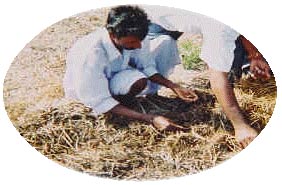 Similar
plans were prepared in the National Drainage Programme (NDP)
during the past several years but they did not succeed as the
powerful bureaucracy did not want any change in their
provincial irrigation departments. Similar
plans were prepared in the National Drainage Programme (NDP)
during the past several years but they did not succeed as the
powerful bureaucracy did not want any change in their
provincial irrigation departments.
This resulted in the performance of NDP much below than its
projected planned programme. One wonders then what was the
point of over-burdening the nation with a foreign loan of US $
785 million for NDP.
Unfortunately, to prepare a foreign loan-oriented budget and
project their wonderful performance during the previous year
has become a routine of successive governments. Eight
five-year plans were based on foreign loans.
With the exception of the Second Five-year plan (due to green
revolution in agriculture) none of these plans did achieve
their targets and maintain the agriculture revolution.
The nation was thus continued to be over-burdened with foreign
debts. Our finance wizards should have told the nation how
much money is spent on the push palaces, secretariats, staff
and expensive cars of our rulers and their so frequent visits
to foreign countries along with a horde of staff causing
unnecessary burden on the nation.
Curtesy: The Dawn
|
Pakissan.com;
|